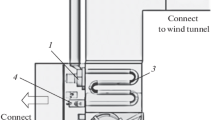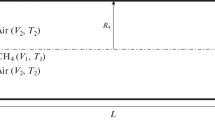Abstract
The structure of a turbulent non-premixed flame of a biogas fuel in a hot and diluted coflow mimicking moderate and intense low dilution (MILD) combustion is studied numerically. Biogas fuel is obtained by dilution of Dutch natural gas (DNG) with CO2. The results of biogas combustion are compared with those of DNG combustion in the Delft Jet-in-Hot-Coflow (DJHC) burner. New experimental measurements of lift-off height and of velocity and temperature statistics have been made to provide a database for evaluating the capability of numerical methods in predicting the flame structure. Compared to the lift-off height of the DNG flame, addition of 30 % carbon dioxide to the fuel increases the lift-off height by less than 15 %. Numerical simulations are conducted by solving the RANS equations using Reynolds stress model (RSM) as turbulence model in combination with EDC (Eddy Dissipation Concept) and transported probability density function (PDF) as turbulence-chemistry interaction models. The DRM19 reduced mechanism is used as chemical kinetics with the EDC model. A tabulated chemistry model based on the Flamelet Generated Manifold (FGM) is adopted in the PDF method. The table describes a non-adiabatic three stream mixing problem between fuel, coflow and ambient air based on igniting counterflow diffusion flamelets. The results show that the EDC/DRM19 and PDF/FGM models predict the experimentally observed decreasing trend of lift-off height with increase of the coflow temperature. Although more detailed chemistry is used with EDC, the temperature fluctuations at the coflow inlet (approximately 100K) cannot be included resulting in a significant overprediction of the flame temperature. Only the PDF modeling results with temperature fluctuations predict the correct mean temperature profiles of the biogas case and compare well with the experimental temperature distributions.
Similar content being viewed by others
References
Abbasi, T., Tauseef, S.M., Abbasi, S.A.: Biogas and biogas energy: An introduction. Biogas Energy, SpringerBriefs in Environmental Science, pp 1–10. doi:10.1007/978-1-4614-1040-9_1 (2012)
Muradov, N.Z., Veziroglu, T.N.: Green path from fossil-based to hydrogen economy: an overview of carbon-neutral technologies. Int. J. Hydrog. Energy 33, 6804–6839 (2008)
Ito, Y., Gupta, A.K., Yoshikawa, K., Shimo, N.: Combustion characteristics of low calorific value gas with high temperature and low-oxygen concentration air. In: Proceedings of the 5th High Temperature Air Combustion and Gasification Conference, Yokohama, Japan (2002)
Cavaliere, A., Joannon, M.D.: Mild combustion. Prog. Energy Comb. Sci. 30, 329–366 (2004)
Cabra, R., Myhrvold, T., Chen, J.Y., Dibble, R.W., Karpetis, A.N., Barlow, R.S.: Simultaneous laser Raman–Rayleigh-lif measurements and numerical modeling results of a lifted turbulent H2/N2 jet flame in a vitiated coflow. Proc. Comb. Inst. 29, 1881–1888 (2003)
Dally, B.B., Karpetis, A.N., Barlow, R.S.: Structure of turbulent non-premixed jet flames in a diluted hot coflow. Proc. Comb. Inst. 29, 1147–1154 (2002)
Oldenhof, E., Tummers, M.J., van Veen, E.H., Roekaerts, D.J.E.M.: Ignition kernel formation and lift-off behaviour of jet-in-hot-coflow flames. Comb. Flame 157, 1167–1178 (2010)
Szegö, G.G.: Experimental and numerical investigation of a parallel jet MILD combustion burner system in a laboratory-scale furnace. PhD thesis, The University of Adelaide (2010)
Plessing, T., Peters, N., Wünning, J.G.: Laseroptical investigation of highly preheated combustion with strong exhaust gas recirculation. Proc. Comb. Inst. 27, 3197–3204 (1998)
Oldenhof, E., Tummers, M.J., van Veen, E.H., Roekaerts, D.J.E.M.: Role of entrainment in the stabilisation of jet-in-hot-coflow flames. Comb. Flame 158, 1553–1563 (2011)
Christo, F.C., Dally, B.B.: Modeling turbulent reacting jets issuing into a hot and diluted coflow. Comb. Flame 142, 117–129 (2005)
Christo, F.C., Dally, B.B.: Application of transport PDF approach for modelling MILD combustion. In: 15th Australasian Fluid Mechanics Conference, Sydney (2004)
Kim, S.H., Huh, K.Y., Dally, B.B.: Conditional moment closure modeling of turbulent nonpremixed combustion in diluted hot coflow. Proc. Comb. Inst. 30, 751–757 (2005)
De, A., Oldenhof, E., Sathiah, P., Roekaerts, D.: Numerical simulation of Delft-jet-in-hot-coflow (DJHC) flames using the Eddy dissipation concept model for turbulence-chemistry interaction. Flow, Turbul. Comb. 87, 537–567 (2011)
Frassoldati, A., Shrama, P., Cuoci, A., Faravelli, T., Ranzi, E.: Kinetic and fluid dynamics modeling of methane/hydrogen jet flames in diluted coflow. Appl. Ther. Eng. 30, 376–383 (2010)
Mardani, A., Tabejamaat, S., Ghamari, M.: Numerical study of influence of molecular diffusion in the MILD combustion regime. Comb. Theory Model. 14, 747–774 (2010)
Mardani, A., Tabejamaat, S., Baig mohammadi, A.: Numerical study of the effect of turbulence on rate of reactions in the MILD combustion regime. Comb. Theory Model. 15, 753–772 (2011)
Aminian, J., Galletti, C., Shahhosseini, S., Tognotti, L.: Numerical investigation of a MILD combustion burner: analysis of mixing field, chemical kinetics and turbulence-chemistry interaction. Flow, Turbul. Comb. 88, 597–623 (2012)
Ihme, M., See, Y.C.: LES flamelet modeling of a three-stream MILD combustor: analysis of flame sensitivity to scalar inflow conditions. Proc. Comb. Inst. 33, 1309–1317 (2010)
Ihme, M., Zhang, J., He, G., Dally, G.: Large eddy simulation of a Jet-in-Hot-Coflow burner operating in the oxygen diluted combustion regime. Flow, Turbul. Comb. 89, 449–464 (2012)
Kulkarni, R.M., Polifke, W.: LES of Delft-Jet-In-Hot-Coflow (DJHC) with tabulated chemistry and stochastic fields combustion model. Fuel Process. Tech. 107, 138–146 (2013)
Cabra, R., Chen, J.Y., Dibble, R.W., Karpetis, A.N., Barlow, R.S.: Lifted methane–air jet flames in a vitiated coflow. Comb. Flame 143, 491–506 (2005)
Ertesvåg, I.S., Magnussen, B.F.: The eddy dissipation turbulence energy cascade model. Comb. Sci. Tech. 159, 213–235 (2000)
Kumar, S., Paul, P.J., Mukunda, H.S.: Prediction of flame liftoff height of diffusion/partially premixed jet flames and modeling of mild combustion burners. Comb. Sci. Tech. 179, 2219–2253 (2007)
Lyons, K.M.: Toward an understanding of the stabilization mechanisms of lifted turbulent jet flames: Experiments. Prog. Energy Comb. Sci. 33, 211–231 (2007)
Kalghatgi, G.T.: Lift-off heights and visible lengths of vertical turbulent jet diffusion flames in still air. Comb. Sci. Tech. 41, 17–29 (1984)
Peters, N., Williams, F.A.: Liftoff characteristics of turbulent jet diffusion flames. AIAA J. 21, 423–429 (1983)
Miake-Lye, R.C., Hammer, J.A.: Lifted turbulent jet flames: a stability criterion based on the jet large-scale structure. Proc. Comb. Inst., 817–824 (1988)
Kazakov, A., Frenklach, M.: Reduced reaction sets based on GRIMech1.2. Available at http://www.me.berkeley.edu/drm./
van Oijen, J.A., Lammers, F.A: Modeling of complex premixed burner systems by using flamelet-generated manifolds. Comb. Flame 127, 2124–2134 (2001)
Sarras, G., Stoellinger, M.K., Roekaerts, D.J.E.M.: Transported PDF simulations of the Delft-jet-in-hot-coflow, burner based on 3D FGM tabulated chemistry. In: Book of Extended Abstracts, Turbulence, Heat and Mass Transfer 7. In: Hanjalic, K., Nagano, Y., Borello, D., Jakirlic, S. (eds.) Begell House Inc (2012)
Etaati, M.A., Stollinger, M., Roekaerts, D.J.E.M.: Tabulated chemistry for three stream non-adiabatic combustion problems. in book of abstracts Combura Symposium, Maastricht, The Netherlands, Published by Technology Foundation STW (2010)
Oldenhof, E.: Autoignition and flame stabilisation processes in turbulent non-premixed hot coflow flames. PhD thesis, Delft University of Technology (2012)
Oldenhof, E., Tummers, M.J., van Veen, E.H., Roekaerts, D.J.E.M.: Transient response of the delft jet-in-hot coflow flames. Comb. Flame 159, 697–706 (2011)
Naud, B., Jimenez, C., Roekaerts, D.J.E.M.: A consistent hybrid PDF method: implementation details and application to the simulation of a bluff-body stabilised flame. Prog. Comp. Fluid Dyn 6, 147–157 (2006)
Merci, B., Naud, B., Roekaerts, D.J.E.M.: Joint scalar versus joint velocity-scalar PDF simulations of bluff-body stabilized flames with REDIM. Flow, Turbul. Comb. 82, 185–209 (2009)
Sarras, G., Stoellinger, M.K., Roekaerts, D.J.E.M.: Transported PDF simulations of the Delft Jet-in-Hot-Coflow burner based on 4D-FGM tabulated chemistry. In: Proceedings of the 6th European Combustion Meeting, Lund, pp. 1–80 (2013)
Peeters, T.W.J.: Numerical modeling of turbulent natural gas flames. PhD thesis, Delft University of Technology (1995)
Bilger, R.W., Stårner S.H., Kee, R.J.: On reduced mechanisms for methane-air combustion in non-premixed flames. Comb. Flame 80, 135–149 (1990)
Oldenhof, E., Tummers, M.J., van Veen, E.H., Roekaerts, D.J.E.M.: Conditional flow fieldstatistics of jet-in-hot-coflowflames. Comb. Flame 160, 1428–1440 (2013)
Ishida, H.: Lift-off and blow-off of laminar jet premixed flame of flammable mixture with Inert Gas. Research reports, Nagaoka College of Technology, Japan, 40, Part 2, pp. 25–28 (2004)
Smith, G.P., Golden, D.M., Frenklach, M., Moriarty, N.W., Eiteneer, B., Goldenberg, M., Bowman, C.T., Hanson, R.K., Song, S., Gardiner Jr., W.C., Lissianski, V.V., Qin, Z.: Gri-Mech 3.0, www.me.berkeley.edu/gri-mech
CHEM1D. A one-dimensional laminar flame code. Eindhoven University of Technology. www.combustion.tue.nl/chem1d
Naud, B., Merci, B., Roekaerts, D.: Generalised Langevin model in correspondence with a chosen scalar-flux second-moment closure. Flow, Turbul. Comb. 85, 363–382 (2010)
Bogacki, P., Shampine, L.F.: A 3(2) pair of Runge-Kutta formulas. Appl. Math. Lett. 2, 321–325 (1989)
Dopazo, C., O’Brien, E.E.: An approach to autoignition of a turbulent mixture. Acta Astron. 1(9), 1239–1266 (1974)
Ramaekers, W.J.S., van Oijen, J.A., de Goey, L.P.H.: A priori testing of flamelet generated manifolds for turbulent partially premixed methane/air flames. Flow, Turbul. Comb. 84, 439–458 (2010)
Arteaga Mendez, L.D., Tummers, M.J., van Veen, E.H., Roekaerts, D.J.E.M.: Effect of hydrogen addition on the structure of natural-gas jet-in-hot-coflow flames. Proc. Combust. Inst., submitted for publication (2014)
Author information
Authors and Affiliations
Corresponding author
Rights and permissions
About this article
Cite this article
Sarras, G., Mahmoudi, Y., Arteaga Mendez, L.D. et al. Modeling of Turbulent Natural Gas and Biogas Flames of the Delft Jet-in-Hot-Coflow Burner: Effects of Coflow Temperature, Fuel Temperature and Fuel Composition on the Flame Lift-Off Height. Flow Turbulence Combust 93, 607–635 (2014). https://doi.org/10.1007/s10494-014-9555-3
Received:
Accepted:
Published:
Issue Date:
DOI: https://doi.org/10.1007/s10494-014-9555-3




